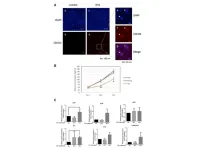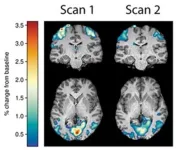(Press-News.org) BUFFALO, N.Y. — Possessing more than two complete sets of chromosomes can be a hindrance to long-term survival of a plant lineage, yet scientists are also finding evidence it’s likely behind some evolutionary innovation.
Sudden inheritance of whole suites of extra gene copies can add redundancy to an organism's regular sets of functions, actually permitting some of those copies to evolve and express in entirely new ways.
In the case of the East Asian pitcher plant, this mutational freedom may have even fine-turned its ability to capture prey and satisfy its appetite for “meat.”
That’s just one of the findings in a new study that sequences the genome of Nepenthes gracilis, a species of carnivorous plant related to Venus flytraps, as well as sundews, beets and spinach.
“Our findings not only provide key insights into the adaptive landscape of the Nepenthes genome, but also broaden our understanding of how polyploidy — having multiple sets of chromosomes — can stimulate the evolution of new functions,” says Victor Albert, PhD, Empire Innovation Professor in the University at Buffalo Department of Biological Sciences, within the College of Arts and Sciences.
Albert is the co-senior author of the study, which was published Thursday (Nov. 23) in Nature Plants, along with Kenji Fukushima, PhD, of the University of Würzburg in Germany. Other contributors from UB include Charlotte Lindqvist, PhD, professor of biological sciences, and PhD students Emily Caroll and Michaela Richter.
Albert’s work was supported in part by the National Science Foundation.
Recessive subgenomes are more free to change function
The idea of “man-eating plants” has long captured our macabre imaginations. Pitcher plants, however, require a much smaller meal.
They capture insects using their highly specialized pitcher-shaped leaves. The bottom of their pitchers are filled with digestive fluids that drown and eventually break down prey. This process releases nutrients, such as nitrogen and phosphate, that allow pitcher plants to thrive in nutrient-poor habitats.
“Plant carnivory is something of a hunt for fertilizer,” Albert says.
In a 1992 study, Albert and colleagues discovered that the Asian, Australian and American pitcher plants possess similar features despite having evolved independently. Later research published in 2017 showed that each of these species co-opted many of the same ancient proteins.
In this new study, Albert and Fukushima’s teams discovered that the specialized pitcher trap of the Asian pitcher plant, or Nepenthes, may have been promoted by polyploidy. Nepenthes’ lineage had already evolved carnivory, so the duplicated genomes may have simply tweaked its mode of capture.
The team discovered that Nepenthes has a decaploid genome in its diploid state, a complex structure almost unprecedented in flowering plants that reflects possession of five whole-genome multiples, or “subgenomes.”
The team found that the fifth subgenome is “dominant,” retaining more gene copies and expressing them at higher levels than the other four older, “recessive” subgenomes. Yet it’s the recessive subgenomes — not the dominant one — that may carry more of the key genes for Nepenthes’ specialized carnivory.
“The dominant subgenome exhibits greater influence of natural selection pressure to maintain gene functions,” Fukushima says. “Whereas the recessive subgenomes, impacted less by functional preservation, have become more free to vary over evolutionary time.”
Some of Nepenthes’ duplicate carnivory genes may have originally evolved for defending against what eventually became their prey. The enzymes that help Nepenthes break down insects’ hard exoskeletons, for example, were repurposed from those that originally shielded plants from being eaten by these animals.
“This lineage of Nepenthes didn't evolve new genes to become carnivorous — they grabbed collections, or toolkits, of genes that were already there,” Albert says.
One hypothesis suggests that polyploidy has a negligible effect on long-term evolution, as species with multiplicated genomes may undergo extinction at rates higher than those like humans, which have just two sets of chromosomes. Yet the study’s findings add to the evidence that ancient polyploidy events can sometimes underlie evolutionary jumps still visible among plants today.
Evidence found for the evolution of separate male and female plants
Nepenthes is part of the just 6% of flowering plant species that are dioecious, meaning each individual plant produces either male or female flowers. In fact, Nepenthes is the only dioecious carnivorous plant.
Albert and Fukushima’s team also identified a male-specific region of the genome containing three genes potentially responsible for controlling these sex differences. One of these, called LEAFY, is a key gene expressed early in flower development that acts as a master regulator.
“LEAFY seems to have had a duplicate form and moved into the Y chromosome region of Nepenthes, thereafter diverging in its function. This use of LEAFY is unprecedented so far in flowering plants,” Albert says. “The LEAFY gene is such a central regulator across flowering plants that, when artificially added or deleted through genetic engineering, it will change a plant’s flowering time.”
“Although we now have bioinformatic evidence pointing toward LEAFY being one of the key genes involved in the sex determination mechanism of Nepenthes, actually proving this is going to require further studies in living plants,” he adds.
END
Genomic study sheds light on how carnivorous Asian pitcher plants acquired signature insect trap
Plants’ duplicated genomes may have paved the way for specialized carnivory, separate-sexed plants
2023-11-30
ELSE PRESS RELEASES FROM THIS DATE:
Harnessing the power of a parasite that can stop pain
2023-11-30
COLUMBUS, Ohio – For the first time, scientists have begun to figure out why the disfiguring skin lesions caused by cutaneous leishmaniasis don’t hurt.
Researchers analyzed leishmaniasis lesions on mouse skin to detect metabolic signaling pathways that differed from uninfected mice. Results suggested the parasites that cause the disease change pain perception – presumably as a way to delay treatment and promote their own survival.
“No one knows why these lesions are painless – ...
Aging modulates extracellular vesicles of epidermal keratinocytes
2023-11-30
“In this article, we describe for the first time the impact of chronological aging on EVs production by human keratinocytes.”
BUFFALO, NY- November 30, 2023 – A new research paper was published on the cover of Aging (listed by MEDLINE/PubMed as "Aging (Albany NY)" and "Aging-US" by Web of Science) Volume 15, Issue 22, entitled, “Chronological aging impacts abundance, function and microRNA content of extracellular vesicles produced by human epidermal keratinocytes.”
The disturbance of intercellular communication is one of the hallmarks of aging. In their new study, researchers ...
Center for BrainHealth publishes new model to predict improvement in brain health
2023-11-30
As part of its ongoing quest to advance better brain health and performance, new research led by Center for BrainHealth at The University of Texas at Dallas investigated neural biomarkers associated with improvements on a brain health index.
The study, “Toward Precision Brain Health: Accurate Prediction of a Cognitive Index Trajectory Using Neuroimaging Metrics,” was recently published in Cerebral Cortex
A total of 48 participants aged 21–65 completed a simple task during a functional magnetic resonance imaging (fMRI) session, then once ...
Scientists find gene therapy reduces liver cancer in animal model
2023-11-30
Researchers at UC Davis Comprehensive Cancer Center have shown that inhibiting a specific protein using gene therapy can shrink hepatocellular carcinoma (HCC) in mice. Silencing the galectin 1 (Gal1) protein, which is often over-expressed in HCC, also improved the anti-cancer immune response and increased the number of killer T cells inside tumors. The study was published in Acta Pharmaceutica Sinica B.
“We’ve long known that Gal1 is a biomarker for hepatocellular carcinoma,” said ...
Air Force awards UTEP Grant to safeguard assets in space
2023-11-30
EL PASO, Texas (Nov. 30, 2023) – Space near earth is teeming with objects, whether natural, like meteors and comets, or manmade, like satellites, spacecraft and rocket debris. But experts still need a clearer picture of the location and state of these objects, which can threaten space-based assets, such as GPS, weather-monitoring and communication satellites.
“The United States is dependent economically and militarily on space assets,” said Miguel Velez-Reyes, Ph.D., chair of the Electrical and Computer Engineering Department at The University of Texas at El Paso. “For ...
Stigmatizing content on social media affects perceptions of mental health care, new study reveals
2023-11-30
Research has shown that social media can negatively impact people's mental health. But can it affect people’s beliefs about mental health treatment?
Yes, according to researchers at Union. In one of the first studies to examine the impact of social media on people’s perceptions of mental health care, researchers discovered that viewing just a few social media posts that mock mental health treatment can have a profound impact on some people's attitudes toward treatment.
The study appears in the latest issue of the journal Social Media + Society.
For the study, 186 participants viewed 10 tweets. The gender ...
New study offers cautious hope about the resilience of redwoods
2023-11-30
New research from Northern Arizona University has explained coast redwood’s remarkable ability to recover from very severe fire, a rare sign of optimism amid a landscape increasingly scarred by severe fires.
The study, published today in Nature: Plants, examined recovery after the catastrophic CZU Lightning Complex Fire, which began in August 2020 and burned thousands of acres of redwoods in Big Basin State Park in California, some more than 1,500 years old. Researchers from NAU’s Center for Ecosystem Science and Society (Ecoss) and the School of Informatics, Computing, and Cyber Systems (SICCS) found, however, that many trees were not dead, as they first appeared. Redwoods ...
The American Institute of Biological Sciences aannounces winner of the IDEAL Leadership Award
2023-11-30
The American Institute of Biological Sciences is pleased to announce Dr. Nyeema C. Harris as the 2023 winner of its Inspiring Inclusivity, Diversity, Equity, Acceptance, and Learning (IDEAL) Leadership Award. The IDEAL Award recognizes commendable leadership in advancing inclusion, diversity, equity, acceptance, accessibility, and learning in the biological sciences community. The award was presented by past awardee Dr. Steward T. A. Pickett on 30 November 2023 at AIBS's Council of Member Societies and Organizations meeting, entitled "Expanding the ...
Thomas Fire research reveals that ash can fertilize the oceans
2023-11-30
(Santa Barbara, Calif.) — Flames roared through Santa Barbara County in late 2017. UC Santa Barbara canceled classes, and the administration recommended donning an N95, long before the COVID pandemic made the mask a household item. Smoke and ash choked the air, but the Thomas Fire’s effects weren’t restricted to the land and sky. Huge amounts of ash settled into the oceans, leaving researchers to wonder what effect it might have on marine life.
Now scientists at UC Santa Barbara have discovered that wildfire ash adds nutrients to marine systems, ...
Study tests firefighter turnout gear with, without PFAS
2023-11-30
Transitioning away from per- and polyfluoroalkyl substances (PFAS), which offer water- and oil-repelling properties on the outer shells of firefighter turnout gear, could bring potential performance tradeoffs, according to a new study from North Carolina State University.
The study showed that turnout gear without PFAS outer shell coatings were not oil-repellent, posing a potential flammability hazard to firefighters if exposed to oil and flame, said Bryan Ormond, assistant professor of textile engineering, chemistry and science at NC State and corresponding author of ...
LAST 30 PRESS RELEASES:
Shingles vaccine linked to slower biological aging in older adults
A self-assembling shortcut to better organic solar cells
A two-week leap in breeding: Antarctic penguins’ striking climate adaptation
Climate risks to insurance and reinsurance of global supply chains
58% of patients affected by 2022 mpox outbreak report lasting physical symptoms
Golden Gate method enables rapid, fully-synthetic engineering of therapeutically relevant bacteriophages
Polar weather on Jupiter and Saturn hints at the planets’ interior details
Socio-environmental movements: key global guardians of biodiversity amid rising violence
Global warming and CO2 emissions 56 million years ago resulted in massive forest fires and soil erosion
Hidden order in quantum chaos: the pseudogap
Exploring why adapting to the environment is more difficult as people age
Society for Laboratory Automation and Screening welcomes new scientific director: Madeline M. Farley, Ph.D.
Austrian cow shows first case of flexible, multi-purpose tool use in cattle
Human nasal passages defend against the common cold and help determine how sick we get
Research alert: Spreading drug costs over the year may ease financial burden for Medicare cancer patients
Hospital partnership improves follow up scans, decreases long term risk after aortic repair
Layered hydrogen silicane for safe, lightweight, and energy-efficient hydrogen carrier
Observing positronium beam as a quantum matter wave for the first time
IEEE study investigates the effects of pointing error on quantum key distribution systems
Analyzing submerged fault structures to predict future earthquakes in Türkiye
Quantum ‘alchemy’ made feasible with excitons
‘Revoice’ device gives stroke patients their voice back
USF-led study: AI helps reveal global surge in floating algae
New method predicts asthma attacks up to five years in advance
Researchers publish first ever structural engineering manual for bamboo
National poll: Less than half of parents say swearing is never OK for kids
Decades of suffering: Long-term mental health outcomes of Kurdish chemical gas attacks
Interactional dynamics of self-assessment and advice in peer reflection on microteaching
When aging affects the young: Revealing the weight of caregiving on teenagers
Can Canada’s health systems handle increased demand during FIFA World Cup?
[Press-News.org] Genomic study sheds light on how carnivorous Asian pitcher plants acquired signature insect trapPlants’ duplicated genomes may have paved the way for specialized carnivory, separate-sexed plants



